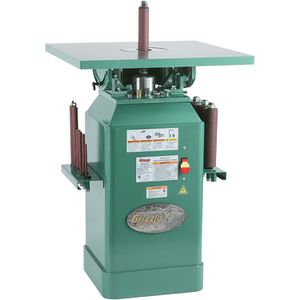Oscillating Spindle Sander
Make: Grizzly Industrial
Model: G1071
Ace: Needed (gdowler@georgefox.edu).
Location: Wood Shop
Description
The Grizzly vertical spindle sander is for sanding curved surfaces. The machine contains a 1HP motor and has 10 different sanding spindles ranging from 1/4" to 4" in diameter. The cast iron table has an opening that allows the spindles to oscillate up and down. The oscillating action will give you a smooth sanded surface. The 4" dust port connects easily to any dust collector. Used to remove material from wood, as well as squaring to create straight pieces.
Here is an example of this piece of equipment being used.
Documentation
Terminology
Insert terminology here
User Manual [G1071_m.pdf] User Manual
Training
Operation
The spindle sander is normally used for sanding inside corners. There are various spindles of va The machine has an on/off power switch located on the control panel. Any conductive material that makes contact with the blade causes the aluminum cartridge block to fire into the blade. The blade then stops spinning and drops down out of the way. All this happens within 5 milliseconds, helping to ensure the blade inflicts minimal damage. This galvanic response safety mechanism is great for preventing injuries but will permanently damage the blade if triggered. If the material you are cutting is conductive it will trigger the saw stop feature. Do not cut any wet lumber, pressure treated, or metal coated materials such as gold leaf with this machine. Charcoal is also conductive so any laser cut areas of lumber should not make contact with the blade while cutting. There are a few other things to keep in mind regarding your material as well. Make sure the material you are cutting is free of all foreign objects. Do not cut materials that may have nails or screws as they will damage the blade and may cause injury to you. Also, if the material contains a loose knot it can break free and create a safety hazard.
If your material looks good, the next step is to set up the saw itself. When setting up the saw the blade, it should protrude no more than 1/4" above the material top. This limits the amount of blade that is exposed and makes for a good cut. You will also want to hook up the adjacent dust collector to the rear of the machine, make sure it is plugged in, and turned on. The dust collector must be used with the table saw to help keep the dust out of the air. As you make a cut, it is imperative that you keep the wood firmly against the fence to make the cut square. Therefore, you should double check to see if you are reading the right measurement on the fence, especially because the fence can be moved to either side of the blade which is why there are two distance indicators, only one of which is correct for each set up. Make sure to ask the supervisor about the available jigs because they can be helpful for specialty cuts. Once the supervisor has demonstrated the use of a jig feel free to use it in the future but do not play around with jigs you are unfamiliar with.
After the saw is set up you are ready to cut. Turn on the saw and slowly push the material through, making sure to keep your hands away from the blade. Do not stop pushing the material until after the cut is finished unless there is an emergency, in which case, carefully use one hand or your hip to bump the off switch. Also not let go of your work piece during the cut or it will be forced back towards you.
Demonstration
Insert text
General Procedure
Insert text
Safety
There are several hazards you need to be aware of when using a spindle sander.
- Never make contact with the rotating spindle. The sand paper is very aggressive and could cause serious injury.
- The spindle is rotating at a high rate of speed and can grab your work piece.
- Hold onto material firmly and keep it against the table. This will help prevent the material from getting pulled out of your hands. If material catches on the spindle it can starts rotating quickly and create a dangerous situation.
Certification
Troubleshooting
Maintenance
General maintenance
As sanding sleeves are used they will "gum up" with saw dust. If not removed, the saw dust will harden and reduce the life of the sanding sleeve. As needed, a abrasive cleaner should be used on the sleeves.
Specific Maintenance Tasks
| Maintenance Procedure | Frequency | Done By |
|---|---|---|
| Sample | Sample | Sample |

